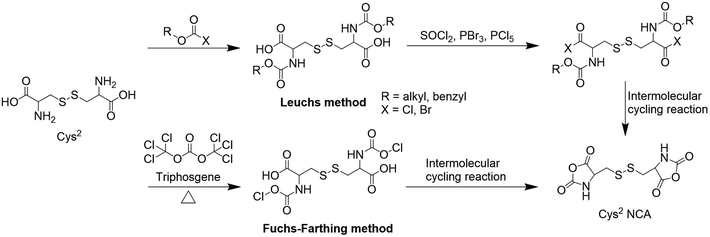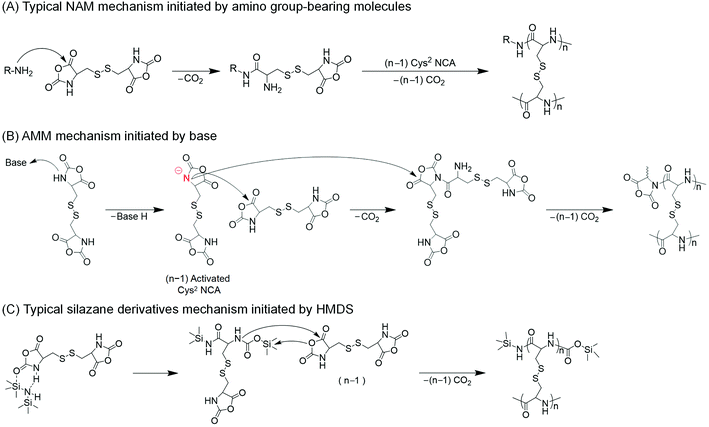Rational construction of polycystine-based nanoparticles for biomedical applications
Jinjin
Chen
 b,
Jiazhen
Yang
ac and
Jianxun
Ding
b,
Jiazhen
Yang
ac and
Jianxun
Ding
 *ac
*ac
aKey Laboratory of Polymer Ecomaterials, Changchun Institute of Applied Chemistry, Chinese Academy of Sciences, 5625 Renmin Street, Changchun 130022, China. E-mail: jxding@ciac.ac.cn
bGuangdong Provincial Key Laboratory of Malignant Tumor Epigenetics and Gene Regulation, Guangdong-Hong Kong Joint Laboratory for RNA Medicine, Medical Research Center, Sun Yat-Sen Memorial Hospital, Sun Yat-Sen University, 107 Yanjiang West Road, Guangzhou 510120, P. R. China
cSchool of Applied Chemistry and Engineering, University of Science and Technology of China, 96 Jinzhai Road, Hefei 230026, P. R. China
First published on 11th May 2022
Abstract
Polypeptide-based nanoparticles are one of the promising excipients of nanomedicines due to their excellent biosafety and flexible modification. Among all the types of polypeptide nanoparticles, polycystine (PCys2)-based ones draw increasing attention due to their unique properties. On the one hand, the uniformed nanogels can be easily obtained through the crosslinking of two active centers during polymerization without additional step of self-assembly. On the other hand, the Cys2-based nanoparticles always showed reduction-responsiveness owing to the inherent disulfide bond. With the development of advanced diagnostic and therapeutic technologies, the multi-functional PCys2-based nanoparticles were achieved via rational construction of the polymer structure. This review summarizes the overall development of Cys2-based polypeptide nanoparticles, especially the structural design for the generation of multi-functional nanoparticles, along with their corresponding biomedical applications.
Introduction
The nanoparticles composed of synthetic polymers have gained considerable attention in nanomedicine owing to their unique properties compared with other nanosystems.1–4 The size, shape, surface properties, and functions of polymer nanoparticles can be easily adjusted by rational design and controlled polymerization, meeting the increasing demands of developing nanomedicine. Among various polymers, polypeptides or polypeptide-containing copolymers show significant advantages in clinical application owing to the superior safety and flexibility of modification.5 First, the major degradation products of nanoparticles formed by polypeptides are amino acids, indicating biodegradability and excellent biocompatibility in the human body.6 Second, the monomers derived from amino acids provide a variety of reactive groups, including hydroxyl, amino, carboxyl, thiol, and so forth, increasing the flexibility in the design and synthesis of nanomaterials with multi-functions.7Nowadays, the traditional nanoparticles are far from the requirements of advanced therapeutic strategies. Stimuli-responsive nanoparticles could be the next generation of nanoparticles due to their ability to release the cargos or self-adjust their morphologies when reaching the desired sites.8,9 Different from the autologous drug release in traditional nanoparticles, the stimuli-responsive nanoparticles release the cargos under a unique microenvironment in the lesion region, mediating increased drug concentration at the desired site. On the other hand, the stimuli-responsive nanoparticles undergo size or shape transitions according to the different requirements during drug delivery, such as tumor penetration, tumor retention, cell uptake, and nucleus delivery. Cystine (Cys2) is a bifunctional amino acid linked by a disulfide bond, which plays a critical role in the tertiary structure of proteins.10 Polycystine (PCys2)-containing polymers exhibit unique advantages in constructing stimuli-responsive nanoparticles compared with other polypeptide nanoparticles.11 First, PCys2-based nanogels can be conveniently obtained by one-pot synthesis, avoiding the additional step of self-assembly from polymers to nanoparticles. Second, the disulfide bond crosslinked polymer network responds to the intracellular reductive microenvironments, enabling controllable disassembly after the cleavage of linkers.12 Therefore, the nanoparticles based on PCys2 are regarded as a promising platform for advanced diagnostic and therapeutic applications.
Controlled polymerization and structural design are two primary strategies for the rational construction of multi-functional nanoparticles. On the one hand, the synthesis and polymerization of L-cystine N-carboxyanhydride (Cys2 NCA) are different from those of other commonly reported amino acids owing to the low solubility of Cys2 in most solvents and the formation of complex polymer networks during polymerization, respectively. On the other hand, the rational design of polymer structure endows PCys2-based nanoparticles with astonishing functions, and the design strategies can be divided into one-pot polymerization, post-polymerization modification, and post-polymerization self-assembly. This review provides an overview of the development of PCys2-based nanoparticles, especially the controlled synthesis and rational construction of polymer structure.
Controlled synthesis of cystine-based polypeptides
PCys2 is usually synthesized through the ring-opening polymerization (ROP) of Cys2 NCA using small or large molecule initiators.13 The ROP of NCAs is theoretically living, so the synthesized polypeptides with a controllable molecular weight, defined chain length, and narrow distribution can be realized in both high yield and quantity.Synthesis of L-cystine N-carboxyanhydride
Since the first successful synthesis of glycine N-carboxyanhydride by Leuchs in 1906, two primary methods have been developed and optimized to increase the yield and purity of NCAs, including the Leuchs and Fuchs–Farthing methods (Scheme 1).14 For the Leuchs method, the carboxyl groups of N-carbamoyl α-amino acids (AAs) are firstly reacted with chlorinating agents, including thionyl chloride (SOCl2), phosphorous pentachloride (PCl5), phosphorus tribromide (PBr3), and so on. Afterward, the NCA ring is formed by an intramolecular annulation reaction. For the Fuchs–Farthing method, AAs are first reacted with phosgene, diphosgene, or triphosgene in inert polar solvents. After the phosgenation reaction, an intramolecular annulation reaction leads to the formation of NCA ring. The Fuchs–Farthing method is most widely used due to its convenience and high purity.For Cys2 NCA, both methods were reported to synthesize the NCA monomer successfully. For example, Qiao and co-workers reported the synthesis of Cys2 NCA via the two-step Leuchs method in 2011.15 In detail, Cys2 was firstly reacted with benzyl chloroformate to obtain benzyloxycarbonyl-protected Cys2 (Cbz-Cys2-OH) (yield = 72.5%). Then Cbz-Cys2-OH was reacted with PCl5 in a 1,4-dioxane:diethyl ether mixture (yield = 70%). SOCl2 and PBr3 were also reported to be applied in the second step with yields of 76.3% and 86%, respectively.16 Our group firstly reported the synthesis of Cys2 NCA by the Fuchs–Farthing method using triphosgene in tetrahydrofuran (THF).17 Although the route of Fuchs–Farthing approach was more simple than that of the Leuchs method, the yield of Leuchs method (up to 86%) was usually much higher than that of the Fuchs–Farthing method (less than 25%). The low solubility of Cys2 in THF might result in such low yield. Recently, a high yield (∼83%) of Cys2 NCA via the two-step Fuchs–Farthing method was achieved using di-N-tert-butyloxycarbonyl-L-cystine (Boc-Cys2-OH) as the reactant, which was highly soluble in anhydrous ethyl acetate.18,19 Since Boc-Cys2-OH is commercially available, the alternative Fuchs–Farthing strategy showed significant advantages compared with traditional methods.
Ring-opening polymerization of L-cystine N-carboxyanhydride
The initiators for the ROP of NCAs are usually nucleophiles or bases, following a “normal amine” mechanism (NAM) or an “activated monomer” mechanism (AMM), respectively.20 The ROP via a NAM mechanism can be initiated by protonic nucleophiles bearing mobile hydrogen atoms, such as primary amines, secondary amines, alcohols, and water. The molecular weight of polypeptide grows linearly along with the consumption of monomers in a NAM mechanism, contributing to a relatively low polydispersity index (PDI). Initiators for the AMM mechanism include bases and alkoxides. First, the deprotonated NCA is generated after the bases abstract the proton. Second, deprotonated NCA acts as an initiator by attacking the 5-CO of another NCA. Although the AMM mechanism obtains the polypeptide with an extremely high molecule weight, the polymerization is uncontrollable and it is hard to obtain well-defined polymers. Different from NAM and AMM, Cheng and his colleagues found that hexamethyldisilazane (HMDS) showed remarkable control over the polymerization of γ-benzyl-L-glutamate N-carboxyanhydride (Bzl-Glu NCA) to generate poly(γ-benzyl-L-glutamate) (P(Bzl-Glu)) with expected molecular weights and narrow PDIs, providing an alternative strategy for the ROP of α-amino acid N-carboxyanhydride (AA NCA).21The NAM mechanism initiated by amino or hydroxyl groups containing macromolecules is the most reported strategy for the ROP of Cys2 NCA (Scheme 2(A)). For example, the amino-terminated methoxy poly(ethylene glycol) (mPEG-NH2) was applied to generate a disulfide bond-crosslinking nanogel.22 Apart from direct initiation by macroinitiators, a small molecular amine (e.g., n-hexylamine) was also used in multiple-step polymerization. For example, the synthesis of poly(N(ε)-benzyloxycarbonyl-L-lysine)–poly(L-phenylalanine-co-L-cystine) (P(Cbz-Lys)–P(Phe-co-Cys2)) was started from the polymerization of N(ε)-benzyloxycarbonyl-L-lysine N-carboxyanhydride (Cbz-Lys NCA) using n-hexylamine as an initiator.23 Afterwards, P(Cbz-Lys) bearing an amino group acted as a macroinitiator to induce the ROP of L-phenylalanine N-carboxyanhydride (Phe NCA) and Cys2 NCA. A strongly basic KOtBu initiator was also used to polymerize multiple di-N-carboxyanhydrides (di-NCAs) to prepare high molecular weight copolymers (Scheme 2(B)).24 Apart from the above traditional initiator, hydroxyl-bearing PEG was applied in the ROP of Cys2 NCA.25 The reaction mixture was heated to 45 °C to accelerate the polymerization due to the relatively low reactivity of hydroxyl group. Silazane derivatives were also used in the controlled polymerization of Cys2 NCA. Qiao and colleagues synthesized a series of star polypeptides containing the PCys2 core using HMDS as an initiator (Scheme 2(C)).15,17,26 Due to the formation of the crosslinked network during polymerization, the molecular weight of polypeptide increased dramatically until the weight ratio of NCA to macroinitiator reached a threshold point.27 Such a threshold point was related to the molecular weight of macroinitiator.
Notably, most of the polymerizations of Cys2 NCA were usually incomplete, with conversion rates of around 70% to 80%, resulting from the formed networks that hindered the reaction between Cys2 NCA and the embedded polymer chain end.24 In a recent study reported by Deming's group, the monomer consumption and yield were evaluated in the copolymerization of different di-NCA monomers with Glu NCA using KOtBu as an initiator.24 The yield could reach more than 90% when the molar percentage of di-NCA was lower than 5%. However, the monomer consumption and yield decreased with the increasing molar percentage of di-NCA. Interestingly, the polymerization of Cys2 NCA resulted in significantly weaker hydrogels compared to other di-NCAs, such as L-homocystine N-carboxyanhydride, L-cystathionine N-carboxyanhydride, and L-lanthionine N-carboxyanhydride. Therefore, developing new di-NCA structures based on Cys2 NCA might be a promising strategy to improve the synthesis efficacy.
Structural design of polycystine-based nanoparticles for biomedical applications
Although the controlled polymerization of Cys2 NCA was investigated in depth, the rational design of structure was also critical for the generation of multi-functional nanoparticles. The construction strategies could be divided into one-pot polymerization, post-polymerization modification, and post-polymerization self-assembly (Fig. 3). Multiple functions, including stimuli-responsive drug release, active targeting, and even smart transformation, could be achieved through the rational structure design.28One-pot polymerization
Well-defined nanoparticles, usually nanogels, can be conveniently prepared via one-pot polymerization without an additional step of self-assembly, owing to the crosslinking along with polymerization mediated by the PCys2 segment (Scheme 3(A)). Such a simple strategy still generates nanoparticles with multiple functions for biomedical applications.6 Co-polymerization with other functional AA NCAs change the properties of the core, leading to adjustable encapsulation for different cargos. Initiation by functional initiators could endow the nanoparticles with active targeting ability.29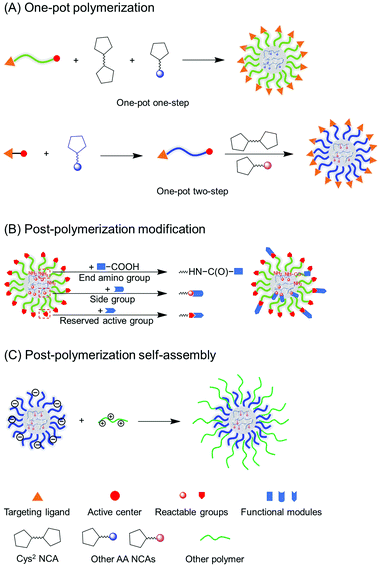 | ||
| Scheme 3 Typical strategies for construction of polymer structure: (A) One-pot polymerization, (B) post-polymerization modification, and (C) post-polymerization self-assembly. | ||
One-pot and one-step polymerization initiated by mPEG-NH2 is the most popular and convenient strategy for constructing reduction-responsive nanogels.30 The PEG block acted as the hydrophilic shell, and the PCys2 block formed the hydrophobic crosslinked core. Such a method quickly generates a well-defined nanogel with a PEG shell without an additional step of self-assembly compared with other types of nanoparticles.31 The PEG-NH2-initiated nanogels usually showed excellent blood circulation and reduction-responsive drug release, broadly used in theranostics of diseases. For example, encapsulation of DOX into the above nanogel improved the therapeutic effect on prostate cancer.32 Further work indicated that the co-delivery of IDO inhibitor 1-methyl-DL-tryptophan (1MT) and DOX induced immunogenic cell death and reversal of immunosuppression.33 Moreover, a similar nanogel exhibited selective drug delivery to the inflammatory joints, which was applied to relieve collagen-induced arthritis.34 Apart from using PEG as an initiator, some natural macromolecules, such as chitosan-bearing amino groups, were also applied in constructing PCys2-based nanoparticles, showing enhanced adhesion in tissues and metals.35
One-pot but two-step polymerization is another strategy for constructing functional nanogels with different surface properties.36 Benefiting from the active manner of ROP, the whole polymerization was separated into two steps in one pot by sequentially adding different NCAs. For example, n-hexylamine first initiated the polymerization of Cbz-Lys NCA, providing an active amino group at the polypeptide end.23,37 Then, Phe NCA and Cys2 NCA were added together into the solution for subsequent polymerization initiated by P(Cbz-Lys). After deprotection and exposure of the amine group, the nanogel exhibited an extremely high positive surface charge, dramatically facilitating the adhesion and penetration to the bladder walls of both mice and rats. Thus, such a positively charged nanogel loaded with 10-hydroxycamptothecin was utilized to treat bladder cancer via intravesical delivery, exhibiting excellent tumor growth inhibition compared with free drugs.
To further improve the capability of encapsulation of the PCys2-based nanoparticles, some other AA NCAs were usually added for copolymerization with Cys2 NCA. Based on the properties of these co-polymerized segments, the cores can be adjusted to be neutral or charged under physiological conditions to meet the requirements of cargos.16 For example, the copolymerization with Phe NCA increased the hydrophobicity of the core, which also facilitated the encapsulation of agents containing an aromatic ring.17,32,34 Increasing the molar percentage of PPhe significantly increased the loading efficiency (DLE) of doxorubicin (DOX) from 14.72% to 70.39%.17
The addition of PLys and PGlu segments could make the core positively or negatively charged under physiological conditions, significantly enhancing the encapsulation of portable cargos.19 For example, copolymerization with Glu increased the DLE of DOX up to 96% by simply mixing in an aqueous solution, avoiding the additional removal of organic solvents.38 In another study, DOX and the hydrophobic drug resveratrol (RES) were loaded into the PGlu-containing nanogel separately.39 The percentage of the PLG segment influenced the DLE of DOX and RES in a total contrast direction. In detail, increasing the PLG segment increased the DLE of DOX but reduced the DLE of RES, resulting from the change of hydrophilicity of the core. In another study, incorporating the PLys segment into a nanogel facilitated the encapsulation of negatively charged molecules.40 For example, anhydride-modified DOX derivatives, including succinyl-DOX (SAD), acid-sensitive cis-aconityl-DOX (CAD), and 2,3-dimethylmaleyl-DOX (DAD), were successfully loaded into a PLys-containing nanogel with a DLE up to 90%. Moreover, the addition of PLys segment slightly accelerated the drug release under reductive conditions owing to the swelling of the core under acidic conditions.
The initiators with functional groups were utilized to construct active targeting nanogels. For example, a dual-targeting nanogel was synthesized by the ROP of methoxy tri(ethylene glycol)-conjugated L-glutamate N-carboxyanhydride (TEGLG NCA), Phe NCA, and Cys2 NCA using phenylboronic acid (PBA) and morpholine (MP) terminated amines as co-initiators (Fig. 1(A)).29 The nanogel (PMNG) could deliver a model drug (DOX) to the tumor cells through not only receptor-mediated targeting to overexpressed sialyl (SA) epitopes but also microenvironment-mediated targeting toward extracellular acidity. The single PBA-modified nanogel (PNG) with only receptor-mediated targeting was also prepared as a control. In vivo distribution of the model drug DOX showed that PMNG could target both primary and metastatic melanoma tumors. In contrast, free and PNG-encapsulated DOX only showed random distribution in the lungs (Fig. 1(B)). Thus, excellent tumor inhibition efficacies of both primary and metastatic models were achieved by the dual-targeting nanogel compared with the single-targeting competitor (Fig. 1(C) and (D)).
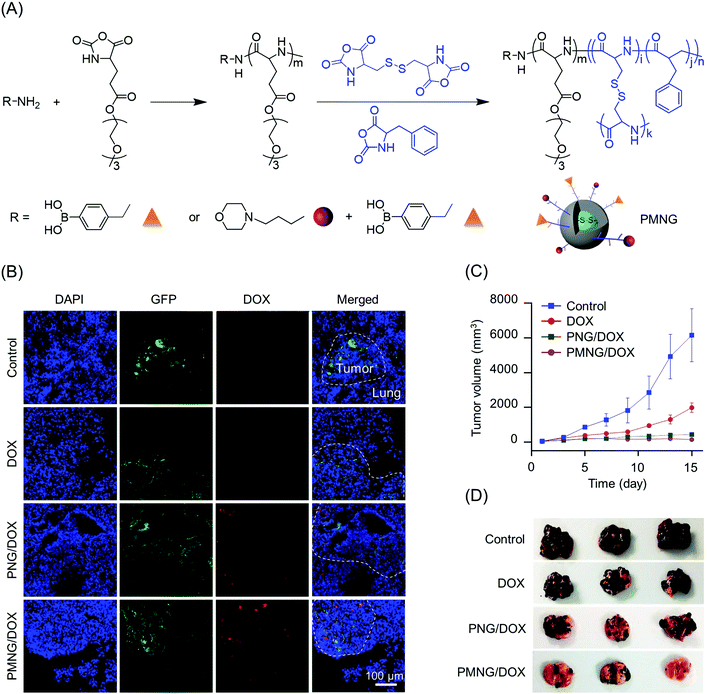 | ||
| Fig. 1 One-pot polymerization for construction of a dual-targeting nanogel. (A) One-pot two-step synthesis of a functional nanogel with active targeting. (B) Distribution of DOX at B16F10 tumor metastasis site. (C, D) Tumor inhibition of primary (C) and metastatic (D) tumor models. Reproduced with permission.29 Copyright 2017, American Chemical Society. | ||
The one-pot polymerization provides a convenient pathway to construct nanogels with different surface and core properties. On the one hand, the initiation by amine-bearing PEG offered the “stealth ability” to the nanogels, reducing the protein absorption and clearance by the reticuloendothelial system.41 Moreover, the polymerization by ligands with active-targeting ability easily constructs the nanogel with targeting motifs on the surface. Notably, such a strategy ensured 100% modification and homogeneous distribution of the ligands on the surface, while traditional post-polymerization modification has incomplete modification and inhomogeneous distribution problems. The adjustable core possessed excellent flexibility of the cargos for encapsulation in the nanogel. The crosslinking by the disulfide bond maintained the structure of nanoparticles when the core was adjusted by copolymerization with other AA NCAs with different charges. Owing to the reduction-responsive disulfide bond, the PCys2-based nanogel showed GSH-accelerated drug release, benefiting the on-demand drug release of nanomedicine.
Post-polymerization modification
Post-polymerization modification is a common method for generating functional polymers or nanoparticles and is also utilized in PCys2-based nanoparticles. Three different strategies are applied to modify PCys2-based nanoparticles via the reaction with the amino group at the polymer end, the reserved active groups in the initiators, and the active groups in the side chain (Scheme 3(B)).The ROP of NCAs is theoretically a living polymerization, leaving a reactive amino group at the terminal of each polymer chain. The amino group could be involved in multiple coupling reactions, such as condensation and Michael addition.42 For example, the N-hydroxysuccinimide (NHS) ester of boron dipyrromethene (BODIPY) was conjugated to the end amino group of the nanogel via amino–carboxyl coupling.43 After the encapsulation of DOX, the nanogel was integrated with the functions of imaging, photodynamic therapy, and chemotherapy. However, the polymer end was usually embedded in the hydrophobic and dense core of the nanogel, which might hinder the efficiency of conjugation.
Compared with the reaction inside the core of the nanogel, the conjugation of active groups reserved in the hydrophilic initiators like PEG was easier and more conducible. Click reaction might be the most popular method for such conjugation owing to the high specificity and reactivity. Thiol-ene and azide–alkyne click reactions were both reported in the modification of nanoparticles. For example, folic acid (FA) and sulfhydryl group terminated PEG were first synthesized and then conjugated with the allyl bond at the end of N-(trimethylsilyl)allylamine-initiated nanogel.26 Selective internalization of the nanogel into FA receptor-overexpressed breast cancer cells (MDA-MB-231) was observed, showing potential for targeted delivery. Another example of the click reaction was reported by Yan's group utilizing azide-modified mPEG-NH2 (mPEG/azide-NH2) as a macroinitiator.44 First, the nanogel was prepared by the ROP of Cys2 NCA initiated by mPEG/azide-NH2. Then, alkyne cyanine was conjugated to the reserved azide group under the catalysis of copper(I). The nanogel also encapsulates other drugs, which might be useful for tumor theranostics.
Owing to the adjustable active groups of co-polymerized amino acids, the modification of nanoparticles post-polymerization was easy to be conducted in these side groups, e.g., the amino group of Lys, carboxyl group of Glu. For example, the NHS ester of a cyanine derivative, a near-infrared fluorescence dye, was conjugated to the side amino group of Lys co-polymerized with Cys2.45 The labeled nanogel was then loaded with DOX for tumor theranostics. Due to the intracellularly reductive conditions within the tumor cells, DOX was released to the cytoplasm and finally observed in the nucleus, while the fluorescence signal of cyanine was still located in the cytoplasm. The nanogel also showed the potential for in vivo imaging with obvious accumulation at the tumor site via the enhanced permeability and retention (EPR) effect. In another study, 2,3-dimethyl-maleic anhydride (DMMA) and Cy5.5 were conjugated to the side amino group of Lys (Fig. 2(A)).46,47 After modification, the nanogel showed pH and reduction-dual responsive behavior, undergoing charge-reversal and disassembly in the extracellular and intracellular tumor microenvironments, respectively (Fig. 2(B)). In vitro experiments showed that the nanogel exhibited an obvious charge-reversal response to pH and accelerated drug release under reductive conditions (Fig. 2(C) and (D)). The charge-reversal benefited the cell uptake of the nanogel, resulting in enhanced cytotoxicity to the tumor cells in vitro (Fig. 2(E)). Moreover, the unreacted NCA ring at the end of polypeptides was also applied for further modification, providing an alternative strategy for constructing functional nanoparticles.15
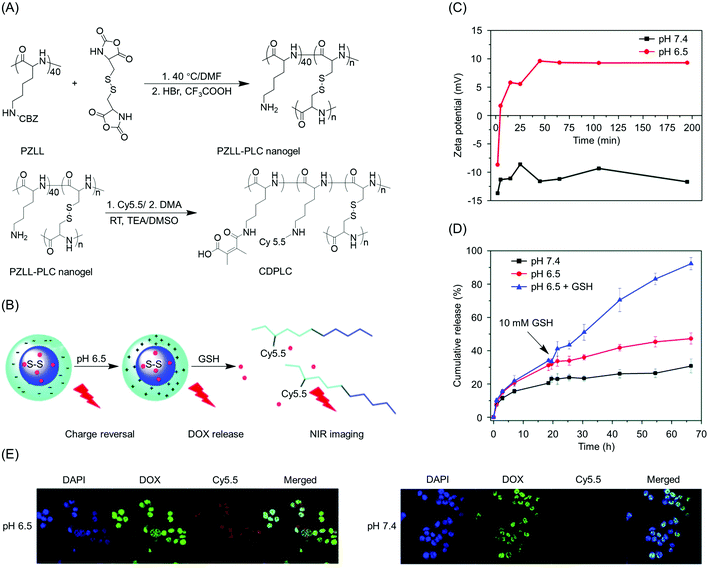 | ||
| Fig. 2 Post-polymerization for preparation of a charge-reversal nanogel. (A) Route of post-polymerization modification. (B) Mechanism of pH and reduction dual-responsive nanogel. (C) pH-responsive charge-reversal of nanogel. (D) pH and reduction dual-responsive drug release. (E) pH-responsive cell uptake of nanogel. Reproduced with permission.47 Copyright 2018, Wiley-VCH. | ||
The crosslinked core formed by Cys2 was a double-bladed sword for the following modification after polymerization. On the one hand, the modification of the end and side groups in the core of the nanogel was usually limited by the dense disulfide bond network. On the other hand, the stable structure of the nanogel benefited the accurate modification of surface ligands, especially the conjugation of large biomacromolecules. Therefore, post-polymerization modification is an alternative pathway for the introduction of molecules, which cannot be involved during polymerization.
Post-polymerization self-assembly
Apart from the strategies based on chemical modification, physical self-assembly post-polymerization shows advantages in generating nanoparticles with multi-level responsiveness (Scheme 3(C)). For ideal drug delivery for tumor therapy, the nanoparticle should have long blood circulation, enhanced accumulation at the tumor site, deep perpetration into the tumor tissues, facilitated cell uptake, and accelerated drug release intracellularly.28,48 The nanoparticles with single or dual responsiveness usually could not meet all these requirements for drug delivery. Thus, the construction of multi-level responsive nanoparticles based on self-assembly post-polymerization was necessary for next-generation nanoparticles for the demands of new therapeutic technology.A sequentially responsive nanoparticle assembled by a polypeptide-based shell and core was constructed via the strategy of post-polymerization self-assembly.49 First, the negatively charged shell and positively charged core were synthesized separately by the ROP. The shell was prepared by modifying the side amino group of Lys in mPEG–PLys with DMMA. The core was obtained via the sequential ROP and deprotection of Cbz-Lys NCA and the Phe NCA/Cys2 NCA mixture. Second, the sequentially responsive nanoparticle was prepared by assembling a mild acid-responsive shell and the above core via electrostatic interaction (Fig. 3(A)). Notably, owing to the rigid helical structure of modified PLys in the shell, the nanoparticle showed a shell-stacked structure, resulting in a dramatic size decrease from 145 to 40 nm after shell-detachment in the extracellular microenvironments of tumor (Fig. 3(B)). The rational construction gave the nanoparticle multi-level responsiveness, including shell-detachment, charge reversal, and reduction-responsive disassembly, providing excellent blood vessel extravasation and tumor penetration compared to the shell-undetachable competitor (Fig. 3(C)).
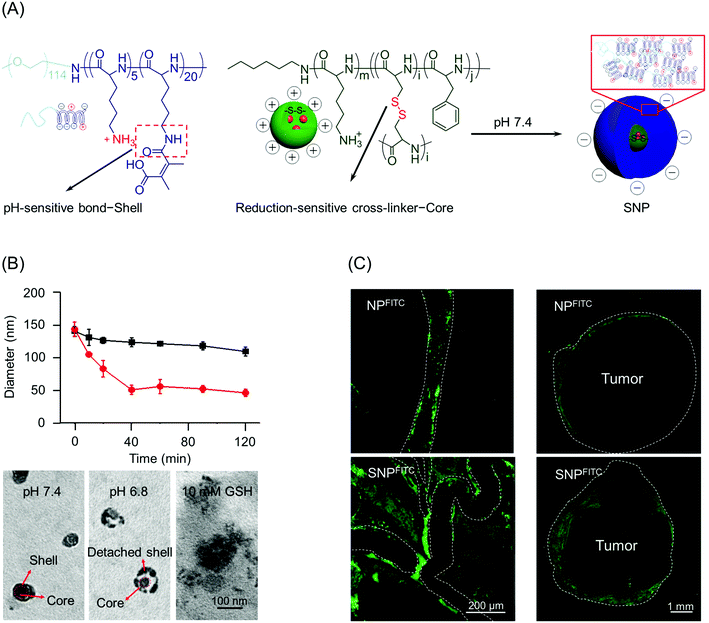 | ||
| Fig. 3 Post-polymerization self-assembly for construction of shell-stacked nanoparticle. (A) Post-polymerization self-assembly for construction of multi-level stimuli-responsive nanoparticle. (B) Shell-detachment induced dramatic decrease in size at pH 6.8. (C) The multi-level stimuli-responsive nanoparticle significantly improved the tumor penetration compared with a single stimulus-responsive competitor. SNP: shell-stacked nanoparticle. NP: shell-undetachable nanoparticle. Reproduced with permission.49 Copyright 2017, Wiley-VCH. | ||
The shell-stacked nanoparticle was further applied in the spatiotemporal delivery of two drugs with different functions.50 Owing to the core–shell structure, combretastatin A-4 phosphate (CA4P, a vascular disrupting agent) and bortezomib (BTZ, a proteasome inhibitor) were loaded separately to the outer shell and inter core of the nanoparticle. The formulated nanoparticle could deliver CA4P to the blood vessels within the tumor to block oxygen and nutrition and BTZ to the tumor cells for the cytotoxic effect. Moreover, the drug resistance caused by CA4P-induced hypoxic conditions was reversed by reduced reflux of the PCys2-based core. The nanoparticle showed excellent tumor inhibition of the A549 xenograft model based on the rational design compared with other single drug-treated groups.
Unlike the chemical modification-mediated construction of multi-functional nanoparticles, the post-polymerization self-assembly was not limited by the active chemical groups and critical reaction conditions. The stable core formed by the disulfide bond of Cys2 was the basis for the following self-assembly with other materials, showing great superiority to other nanoparticles. First, the stable core provided a rigid scaffold for the following self-assembly, ensuring the maintenance of spherical structure. Second, due to the adjustable surface properties they interact with other materials via various interactions mediated by the functional surface groups. Such a strategy showed unlimited possibilities for the construction of nanoparticles with astonishing functions. Moreover, assembling with other materials instead of polypeptides further expanded the application of PCys2-based nanoparticles.
Conclusions
Disulfide bond is critical for forming the tertiary structure of protein, and polypeptides composed by Cys2 with disulfide bond provide exciting properties in the biomedical field. Different from other linear or branched polymers, which require additional self-assembly steps to obtain nanoparticles, the polypeptide based on Cys2 was self-crosslinked by the disulfide bond, resulting in the generation of a well-defined nanogel during polymerization. Moreover, the PCys2-based nanoparticles had the reduction-responsive core, which could be utilized for stimuli-responsive drug release and have great potential for biomedical applications.Controlled synthesis and structural design are essential to generate multi-functional nanoparticles that meet the requirements of rapidly developing diagnostic and therapeutic technologies. On the one hand, the ROP of NCAs was the commonly applied method for the controlled synthesis of Cys2-based polypeptide nanoparticles. For the preparation of Cys2 NCA, the Leuchs method showed a better yield compared with the Fuchs–Farthing one. For the ROP of Cys2 NCA, amino-bearing molecules and HMDS were the most popular initiators. Notably, the yield of polypeptide showed relevance to the molar percentage of Cys2 NCA. Increasing the molar percentage of Cys2 NCA reduced the consumption of monomer, which might result from that the dense core embedded the amino group at the polymer end and subsequently hindered the initiation of remaining NCA. On the other hand, the structural design was also essential to generate multi-functional nanoparticles. Basically, three strategies were used to construct PCys2-based nanoparticles, including one-pot polymerization, post-polymerization modification, and post-polymerization self-assembly. The last method showed unlimited possibilities to form various hybrid nanoparticles with multi-level responsiveness compared with the former two limited by chemical reactions.
PCys2-based nanoparticles were widely applied in different biomedical applications. The adjustable core ensured the feasibility of cargos, making these nanoparticles ideal drug carriers. Conjugation or encapsulation of imaging dyes turned the nanoparticles into nanoprobes for disease diagnosis. Nanoparticles with different surface properties, e.g., PEGylated, positively charged, or targeting-ligand conjugated, had broad applications, including intravenous injection, intravesical delivery, joint-targeting delivery, and so on. Most importantly, the investigation of multi-level responsive smart nanoparticles based on the Cys2-containing polypeptide showed the possibility of fulfilling the various and even contradictory demands simultaneously. However, the PCys2-based nanoparticles are still faced with multiple challenges for further development. First, the uncompleted conversion of Cys2 NCA usually resulted in an uncontrollable polymerization rate and molecular weight of the nanogel, hindering the standard manufacturing for clinical application. Second, the encapsulation of cargos into the core of the nanogel should be carried out after the swelling of dense network in organic solvents, which requires further purification to remove the solvents. Finally, the PCys2-based nanogels formed by the disulfide bond only showed reduction-responsiveness. With the development of advanced therapeutic strategies targeting other stimuli, e.g., reactive oxygen species and enzymes, the PCys2-based nanogels cannot meet the demands for these applications. Taken together, PCys2-based nanoparticles still showed great potential for biomedical applications, providing a bright future when combined with new diagnostic and therapeutic technologies.
Author contributions
Jinjin Chen: conceptualization, resources, writing – original draft, writing – review & editing; Jiazhen Yang: visualization, writing – review & editing; Jianxun Ding: conceptualization, funding acquisition, supervision, writing – review & editing.Conflicts of interest
There are no conflicts to declare.Acknowledgements
This study was financially supported by the National Natural Science Foundation of China (Nos. 52022095, 52073280, 51973216, 51873207, and 51833010), the Science and Technology Development Program of Jilin Province (Nos. 20210509005RQ and 20200404182YY), the Youth Innovation Promotion Association of Chinese Academy of Sciences (No. 2019230), and the Program of Guangdong Science and Technology Department (Nos. 2020B1212030004 and 2020B1212060018).References
- M. Elsabahy and K. L. Wooley, Chem. Soc. Rev., 2012, 41, 2545–2561 RSC
.
- N. Kong, R. Zhang, G. Wu, X. Sui, J. Wang, N. Y. Kim, S. Blake, D. De, T. Xie, Y. Cao and W. Tao, Proc. Natl. Acad. Sci. U. S. A., 2022, 119, e2112696119 CrossRef CAS PubMed
.
- Y. Xiao, Z. Tang, X. Huang, J. Joseph, W. Chen, C. Liu, J. Zhou, N. Kong, N. Joshi, J. Du and W. Tao, Matter, 2021, 4, 3269–3285 CrossRef CAS
.
- N. Kong, W. Tao, X. Ling, J. Wang, Y. Xiao, S. Shi, X. Ji, A. Shajii, S. T. Gan, N. Y. Kim, D. G. Duda, T. Xie, O. C. Farokhzad and J. Shi, Sci. Transl. Med., 2019, 11, eaaw1565 CrossRef CAS PubMed
.
- C. Deng, J. Wu, R. Cheng, F. Meng, H. A. Klok and Z. Zhong, Prog. Polym. Sci., 2014, 39, 330–364 CrossRef CAS
.
- Y. Liu, D. Li, J. Ding and X. Chen, Chin. Chem. Lett., 2020, 31, 3001–3014 CrossRef CAS
.
- Z. Jiang, J. Chen, L. Cui, X. Zhuang, J. Ding and X. Chen, Small Methods, 2018, 2, 1700307 CrossRef
.
- C. Zheng, M. Li and J. Ding, BIO Integr., 2021, 2, 57–60 CrossRef
.
- X. Qin and Y. Li, ChemBioChem, 2020, 21, 1236–1253 CrossRef CAS PubMed
.
- T. Meitinger, A. Meindl, P. Bork, B. Rost, C. Sander, M. Haasemann and J. Murken, Nat. Genet., 1993, 5, 376–380 CrossRef CAS PubMed
.
- J. Z. Yang, H. Y. Zou, J. X. Ding and X. S. Chen, Acta Polym. Sin., 2021, 52, 960–977 Search PubMed
.
- P. F. Monteiro, A. Travanut, C. Conte and C. Alexander, Wiley Interdiscip. Rev.: Nanomed. Nanobiotechnol., 2021, 13, e1678 CAS
.
- M. N. Leiske and K. Kempe, Macromol. Rapid Commun., 2022, 43, 2100615 CrossRef CAS PubMed
.
- H. Leuchs, Ber. Dtsch. Chem. Ges., 1906, 39, 857–861 CrossRef CAS
.
- A. Sulistio, A. Widjaya, A. Blencowe, X. Zhang and G. Qiao, Chem. Commun., 2011, 47, 1151–1153 RSC
.
- P. Bilalis, S. Varlas, A. Kiafa, A. Velentzas, D. Stravopodis and H. Iatrou, J. Polym. Sci., Part A: Polym. Chem., 2016, 54, 1278–1288 CrossRef CAS
.
- J. Ding, F. Shi, C. Xiao, L. Lin, L. Chen, C. He, X. Zhuang and X. Chen, Polym. Chem., 2011, 2, 2857–2864 RSC
.
- O. C. Onder, P. Utroša, S. Caserman, M. Podobnik, M. T. Žnidarič, J. Grdadolnik, S. Kovačič, E. Žagar and D. Pahovnik, Polym. Chem., 2020, 11, 4260–4270 RSC
.
- O. C. Onder, P. Utroša, S. Caserman, M. Podobnik, E. Žagar and D. Pahovnik, Macromolecules, 2021, 54, 8321–8330 CrossRef CAS
.
- N. Hadjichristidis, H. Iatrou, M. Pitsikalis and G. Sakellariou, Chem. Rev., 2009, 109, 5528–5578 CrossRef CAS PubMed
.
- H. Lu and J. Cheng, J. Am. Chem. Soc., 2007, 129, 14114–14115 CrossRef CAS PubMed
.
- X. Feng, W. Xu, X. Xu, G. Li, J. Ding and X. Chen, Sci. China: Chem., 2021, 64, 293–301 CrossRef CAS
.
- H. Guo, W. Xu, J. Chen, L. Yan, J. Ding, Y. Hou and X. Chen, J. Controlled Release, 2017, 259, 136–148 CrossRef CAS PubMed
.
- E. D. Raftery, E. G. Gharkhanian, N. G. Ricapito, J. McNamara and T. J. Deming, Chem. - Asian J., 2018, 13, 3547–3553 CrossRef CAS PubMed
.
- L. Liu, T. Li, Z. Ruan, P. Yuan and L. Yan, Mater. Sci. Eng., C, 2018, 92, 745–756 CrossRef CAS PubMed
.
- A. Sulistio, J. Lowenthal, A. Blencowe, M. N. Bongiovanni, L. Ong, S. L. Gras, X. Zhang and G. G. Qiao, Biomacromolecules, 2011, 12, 3469–3477 CrossRef CAS PubMed
.
- A. Sulistio, A. Blencowe, A. Widjaya, X. Zhang and G. Qiao, Polym. Chem., 2012, 3, 224–234 RSC
.
- J. Chen, Z. Jiang, Y. S. Zhang, J. Ding and X. Chen, Appl. Phys. Rev., 2021, 8, 041321 CAS
.
- J. Chen, J. Ding, W. Xu, T. Sun, H. Xiao, X. Zhuang and X. Chen, Nano Lett., 2017, 17, 4526–4533 CrossRef CAS
.
- T. Xing, B. Lai, X. Ye and L. Yan, Macromol. Biosci., 2011, 11, 962–969 CrossRef CAS PubMed
.
- W. Yu, M. Shevtsov, X. Chen and H. Gao, Chin. Chem. Lett., 2020, 31, 1366–1374 CrossRef CAS
.
- L. He, D. Li, Z. Wang, W. Xu, J. Wang, H. Guo, C. Wang and J. Ding, Polymers, 2016, 8 CAS
.
- X. Feng, W. Xu, J. Liu, D. Li, G. Li, J. Ding and X. Chen, Sci. Bull., 2021, 66, 362–373 CrossRef CAS
.
- N. Feng, M. Yang, X. Feng, Y. Wang, F. Chang and J. Ding, ACS Biomater. Sci. Eng., 2018, 4, 4154–4162 CrossRef CAS PubMed
.
- D. Lu, H. Wang, X. Wang, Y. Li, H. Guo, S. Sun, X. Zhao, Z. Yang and Z. Lei, Carbohydr. Polym., 2019, 215, 20–28 CrossRef CAS
.
- A. Sulistio, A. Blencowe, A. Widjaya, X. Zhang and G. Qiao, Polym. Chem., 2012, 3, 224–234 RSC
.
- H. Guo, F. Li, W. Xu, J. Chen, Y. Hou, C. Wang, J. Ding and X. Chen, Adv. Sci., 2018, 5, 1800004 CrossRef
.
- F. Shi, J. Ding, C. Xiao, X. Zhuang, C. He, L. Chen and X. Chen, J. Mater. Chem., 2012, 22, 14168–14179 RSC
.
- W. Wang, L. Zhang, M. Liu, Y. Le, S. Lv, J. Wang and J. F. Chen, RSC Adv., 2016, 6, 6368–6377 RSC
.
- J. Ding, F. Shi, D. Li, L. Chen, X. Zhuang and X. Chen, Biomater. Sci., 2013, 1, 633–646 RSC
.
- A. Kolate, D. Baradia, S. Patil, I. Vhora, G. Kore and A. Misra, J. Controlled Release, 2014, 192, 67–81 CrossRef CAS PubMed
.
- B. Mahjour, Y. Shen, W. Liu and T. Cernak, Nature, 2020, 580, 71–75 CrossRef CAS PubMed
.
- L. Liu, T. Li, Z. Ruan, P. Yuan and L. Yan, Mater. Sci. Eng., C, 2018, 92, 745–756 CrossRef CAS PubMed
.
- T. Xing, B. Lai and L. Yan, Macromol. Chem. Phys., 2013, 214, 578–588 CrossRef CAS
.
- T. Xing, C. Mao, B. Lai and L. Yan, ACS Appl. Mater. Interfaces, 2012, 4, 5662–5672 CrossRef CAS PubMed
.
- T. Jing, T. Li, Z. Ruan and L. Yan, J. Mater. Sci., 2018, 53, 14933–14943 CrossRef CAS
.
- T. Jing, T. Li, Z. Ruan, Q. Cheng and L. Yan, Macromol. Mater. Eng., 2018, 303, 1800060 CrossRef
.
- J. Ding, J. Chen, L. Gao, Z. Jiang, Y. Zhang, M. Li, Q. Xiao, S. S. Lee and X. Chen, Nano Today, 2019, 29, 100800 CrossRef CAS
.
- J. Chen, J. Ding, Y. Wang, J. Cheng, S. Ji, X. Zhuang and X. Chen, Adv. Mater., 2017, 29, 1701170 CrossRef PubMed
.
- J. Chen, Z. Jiang, W. Xu, T. Sun, X. Zhuang, J. Ding and X. Chen, Nano Lett., 2020, 20, 6191–6198 CrossRef CAS PubMed
.
| This journal is © The Royal Society of Chemistry 2022 |


